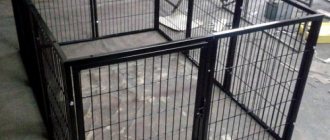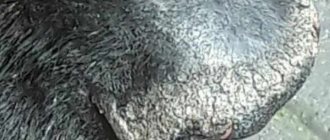Heart failure manifests itself in the form of the following symptoms:
- decreased endurance, refusal of the dog to move a lot;
- increased need for drinking water - thirst;
- rapid breathing even in a cool room, breathing with an open mouth;
- noisy breathing (wheezing);
- blue tongue after slight physical exertion;
- cough in the absence of colds;
- short-term loss of consciousness (often during walks).
Heart disease in dogs can be divided into 3 large groups:
- Congenital heart defects.
- Acquired heart failure (after previous infectious diseases or as complications of current diseases)
- Heart disease in old dogs of advanced age.
The first group of diseases occurs in young dogs and puppies. It is characterized by vivid symptoms of heart failure (wheezing, shortness of breath, blue tongue, fainting, or even the death of a puppy at a very early age).
The second group is more common among middle-aged dogs.
Symptoms of heart failure can be hidden (changes can be seen only on an R-image or on an ECG), and when the development of heart failure reaches stage II-III, signs of the disease already appear (7 signs described above). The causes of such conditions are different: heart valve insufficiency, dilation of the heart chambers (cardiomyopathy), infection with heartworms (dirofilariasis), myocarditis after piroplasmosis.
Attention! It should be especially noted that with the disease dirofilariasis (heartworms), failure of the right chambers of the heart develops when the animal’s right atrium and ventricle enlarge (since this is the habitat of adult helminths) and symptoms of circulatory failure appear and ascites (fluid in the abdominal cavity) appears.
.
Only a complete examination will be able to understand all the reasons and help make a correct diagnosis.
The third group of diseases often occurs in dogs after 8 years of age and occurs with clearly visible symptoms: coughing, wheezing when breathing, increased respiratory rate, increased thirst, loss of coordination, loss of consciousness.
What is the reason for a dog owner to contact a veterinary cardiologist?
Let's divide the animals into III age groups.
What should alarm the owner of a puppy (from 2.5 months to 1 year):
- He doesn't eat well, doesn't gain weight well, doesn't play, and sleeps all the time. (Healthy, phlegmatic puppies sleep a lot, of course, but they still play between naps)
- The puppy actively moves, plays, “runs around”, but after active movements it cannot catch its breath, breathes with high frequency, with an open mouth, and then becomes lethargic for a while.
- Constant shortness of breath and cyanotic tongue, fainting are unfavorable symptoms indicating severe changes in the functioning of the heart.
- Cough after active movements.
What should alarm the owner of an adult dog aged 3 to 7 years:
- Shortness of breath at rest.
- Inexplicable lethargy, weakness.
- Sudden loss of consciousness (fainting) - often while walking.
- Cough or "cough". Often owners indicate something between gagging and coughing.
- Excessive weight gain and increased thirst.
What should alarm the owner of an adult dog aged 8 to 15 years:
- dull cough in the absence of colds;
- lack of coordination, unsteady gait;
- breathing with your mouth open in a cool room;
- inexplicable anxiety, combined with shortness of breath, rapid breathing with an open mouth;
- weakness, refusal to eat, rare breathing;
- breathing with an open mouth with a noticeable blueness of the tongue (this is already a reason to call emergency veterinary help);
- the dog has changed the position of its forelimbs: it places its elbows wide apart, as if they are turned outward;
- The volume of the abdomen has increased.
Many owners are disappointed with the service in clinics, not understanding what is the reason for their pet’s poor condition.
The main criterion for a correct cardiac examination is a comprehensive study. It is impossible to make a diagnosis of congenital heart disease only after auscultation (listening with a phonendoscope).
A cardiac examination begins with a general examination and auscultation. This is followed by an X-ray examination of the chest, then the doctor examines the ECG and, if the device allows, then monitoring for at least 10–15 minutes to detect cardiac arrhythmias. The final stage of the examination is an ultrasound of the heart. Each method carries its own information; when combined, a cardiologist can make the correct diagnosis and prescribe treatment.
After taking heart medications, it is necessary to monitor the condition, i.e., be sure to repeat the ECG to determine the effectiveness of treatment. It often happens that during a mandatory examination before a planned operation, an ECG is taken on the dog and cardiac abnormalities are detected that were not clinically manifested and the owner did not notice them, but during a subsequent survey they remember, for example, that the dog occasionally coughs at night or breathes frequently after walks, nothing can't catch his breath when he gets home.
In conclusion, I would like to say that when purchasing a puppy, owners should pay attention to the symptoms described above, and also see a doctor who will help you recognize the initial signs of heart pathologies in order to begin treatment on time. Better than any treatment is prevention and preventing the disease from developing to a severe stage.
Health to your pets, and happiness to you.
___________________
Source: Kurganova Marina Yurievna - cardiologist at the Belanta veterinary clinic
Source: www.belanta.vet
What to do if your dog's tongue turns blue
If your dog's tongue falls out and turns blue, contact the nearest 24-hour veterinary clinic. In acute cases, minutes count. If the attack occurred at night, do not delay the examination until the morning. This could cost your pet his life.
First aid
Before visiting the veterinarian, the owner can only alleviate the condition of his pet. If your dog has difficulty breathing, follow these steps:
- Place the dog on its side and prevent it from moving.
- Open all windows in your room or car to replenish your oxygen levels.
- Be sure to clear the mouth and nose of accumulated secretions.
- On the way to the veterinary clinic, do not forget to calm the animal with strokes and gentle words.
Try to keep your emotions under control so as not to worry your four-legged dog, and do not use medications without prescription. They can aggravate the condition and cause complications.
Treatment of cardiovascular diseases
Depending on the diagnosis, the following medications may be required for treatment:
- ACE inhibitors, which lower blood pressure;
- diuretics, removing excess fluid;
- antitussives;
- cardiotonics that increase the force of heart contraction;
- vasopressors, constrictors of blood vessels;
- antibiotics that fight concomitant infections;
- glucocorticosteroids used in antishock therapy;
- immunomodulators that stimulate the body's protective function.
Additional recommendations include reviewing your diet and reducing your usual exercise routine. Usual portions are reduced to avoid obesity, and salt, which causes swelling, is removed from food.
Treatment of respiratory diseases
If the condition is severe, oxygen therapy and fluid pumping may be required. After feeling better, they move on to eliminating the root cause and accompanying symptoms. For this, the following drugs are prescribed:
- diuretics;
- bronchodilators that relieve spasms in the bronchi;
- sedatives that reduce anxiety;
- antibiotics;
- vasodilators, dilating blood vessels;
- glucocorticosteroids that suppress allergic reactions;
- respiratory stimulants that normalize heartbeat.
Until the animal’s condition stabilizes, the animal is left in the hospital on infusion therapy. All this time, doctors are keeping an eye on him, who can quickly help if a new attack occurs.
When rapid breathing is normal
Ventilation of an animal's lungs depends on a large number of factors. A dog's panting may occur due to very hot weather or physical activity. After walks or street games, your pet's heartbeat will increase. Therefore, the normal consequence will be intermittent and rapid breathing in the dog for the next half hour.
There is no need to worry about rapid breathing caused by intense emotions of rage or excitement. A trip to a place far from home, a visit to the veterinarian, or a noisy crowd of people disturbs the pet. Stress and nervous situations also cause shortness of breath. Tachypnea can also indicate physiological characteristics such as pregnancy or sexual arousal.
There is nothing surprising in the dog having difficulty breathing when the oxygen supply is reduced in confined spaces. Also, the frequency of breaths depends on what the dog breathes. It is better to exclude walking in industrial zones. Toxic trace elements can settle on the animal's lungs and cause breathing difficulties.
Due to their anatomical structure, breeds with a flat nose suffer from tachypnea throughout their lives. Therefore, if such a dog breathes frequently and sticks out its tongue, this is the norm. The pet may also wheeze and sniffle in its sleep. This only indicates a relaxed breathing apparatus or an uncomfortable posture during rest.
What is cyanosis
Cyanosis, or blue discoloration of mucous membranes, is an alarming symptom that accompanies many dangerous diseases. It is not an independent disease, so the natural color returns only after the cause of its appearance is eliminated.
State Definition
With cyanosis, the dog's tongue, other mucous membranes and even the skin turn blue. Depending on the severity of the condition, the color varies from gray-blue to dark purple. Such changes occur when blood circulation is impaired and the level of oxygen in the blood decreases.
Varieties
According to the degree of distribution, cyanosis is divided into local and total. In the first case, only individual areas change color, and in the second, the entire body changes color.
Depending on the location, local cyanosis is divided into 2 more types:
- central, involving the mucous membranes of the oral cavity, the area around the eyes and nose;
- peripheral, changing the color of areas distant from the heart (paws, ears).
Based on the speed of development and severity of accompanying symptoms, acute and chronic cyanosis are distinguished. The first progresses quite quickly and can lead to sudden death. The second type develops very slowly, so for a long time, cyanosis may remain the only alarming symptom.
Warning signs
Tachypnea in dogs is not always a harmless phenomenon. If, against the background of restless breathing, the animal exhibits other symptoms - weakness, shortness of breath, diarrhea, convulsions, vomiting - you should immediately seek help from a veterinarian. Respiratory dysfunction may have the following causes:
- respiratory viral infections;
- foreign body blocking the airway;
- inflammation of the bronchi, trachea or larynx;
- heart failure;
- open or closed injury to vital organs.
There are two types of difficulty breathing in dogs: superficial and deep. Superficial increase in frequency is usually associated with fever, inflammation of the bronchi, or swelling of the lung tissue.
If your pet is breathing quickly but deeply, it may be due to oxygen deficiency. A stressful situation and heavy exertion also cause deep shortness of breath.
Additional symptoms
If wheezing tachypnea occurs suddenly and is not preceded by exercise, the dog may be in a dangerous condition. Therefore, if you notice the following serious symptoms, you should immediately contact your veterinarian:
- Fever. It should range from 37C to 39C. If there is a deviation from these indicators, then in combination with difficulty breathing, this may indicate the presence of a viral infection.
- Wheezing. If it occurs, you should first check your pet's larynx. A foreign body could have entered there, causing fluid swelling that makes it difficult for the dog to breathe.
- Vomit. If an animal vomits in addition to tachypnea, this indicates an allergy, poisoning or overeating. In this case, drooling may also occur heavily.
- Shiver. May occur with hypoglycemia or viral hepatitis.
- The occurrence of seizures along with rapid breathing may indicate an epileptic attack.
- A blue tongue is the most frightening sign. He talks about pulmonary edema or heart problems.
- The dog begins to arch its back strangely or whine. This may indicate intervertebral disc disease, hernia or osteochondrosis.
Treatment of pulmonary diseases
Why and why a dog has a blue tongue is described above. How to cope with diseases of the respiratory system that can cause such a pathological condition?
The need to use a particular drug, as well as the dosage (based on the dog’s weight), can only be prescribed by a qualified veterinarian; self-medication can be dangerous to the pet’s health.
After vaccination
Often, after canine injections, dogs begin to experience a convulsive heart rhythm or tachycardia. These processes are accompanied by tachypnea. If it is difficult for an animal to inhale and exhale normally immediately after vaccination, the first thing you need to understand is that this is not an allergy. It can lead to anaphylactic shock and cause death. Therefore, it is necessary to stay with your pet in the clinic for half an hour after the procedure.
If a dog is breathing spasmodically several hours after vaccination, this means that the immune system has responded to the vaccine. In this case, a high breathing rate may be accompanied by loss of appetite, decreased activity, indigestion and fever. Typically, respiratory function returns to normal within 24 hours.
Visit to the veterinarian
At the appointment, the veterinarian examines the four-legged animal, listens to its chest and checks its heart function. To do this, he uses the following research:
- auscultation, detecting extraneous noise;
- pulse oximetry, which measures the degree of oxygen saturation in the blood;
- urine and blood tests to detect concomitant disorders;
- ECG, which determines heart rhythm;
- Ultrasound and x-rays that reveal pathological changes inside the lungs and heart.
The doctor may supplement the standard list with pleural puncture, bronchoalveolar lavage, or other studies. The final amount depends on the difficulty of identifying the main cause of the ailment.
Overheating of the animal
When a dog experiences heatstroke, it may experience rapid breathing, as if it has undergone a lot of physical exertion. The animal becomes lethargic. As first aid, you should provide the dog with access to water. The dog is placed in a cool and well-ventilated area. If your dog continues to breathe heavily after this, you can apply ice to the head and belly. You can also cover your pet with a wet towel.
If respiratory function has not recovered within 24 hours, you should consult a veterinarian.
Treatment of heart diseases
If a dog has a blue tongue, what should you do in this case? It is important to have the animal checked by a veterinarian for pathologies of the cardiovascular system. What diseases can be detected? How to treat them?
In addition, it is important to adhere to a salt-free diet and nutrition regimen. If your dog is overweight, it is necessary to consult a veterinarian for further weight loss, since obese animals significantly increase the load on the cardiovascular system.
After anesthesia
The dog is breathing frequently due to serious medical procedures. Anesthesia is stress for the body. After this, the animal may be in a restless state. This happens when the effect of anesthesia wears off and the dog begins to experience discomfort after the intervention. In this case, the pet is given an anesthetic drug that the veterinarian recommended as treatment.
Tachypnea in this case may indicate intoxication of the body or pulmonary edema after surgery. It is impossible to cope with these problems at home, so you need to urgently take the animal to a veterinary clinic.
Breathing during pregnancy
It is especially important to monitor the breathing of a pregnant bitch. In this position, tachypnea may signal impending labor. If a pregnant dog is breathing heavily in the late stages, there is no reason to worry.
However, rapid breathing in a dog in the early stages should cause concern for the owner. It is necessary to exclude the possibility of pathology and prevent the occurrence of miscarriage.
It is impossible to do this on your own, so it is recommended to seek help from specialists. During lactation, the dog's breathing is also uneven, which is not a deviation.
First aid
First of all, it is necessary to quickly eliminate external factors: stress, heat, anxiety. You should provide the dog with a comfortable environment. It is necessary to create good ventilation in the room where the pet will lie. In order not to aggravate the situation, you should not lift the animal’s head and forcefully feed it water. If the temperature is high, you can apply ice.
If the dog begins to choke, tremble and cough, you should resort to an oxygen mask. If your tongue turns blue, which is a sign of heart failure, you should place heating pads on your dog's paws. But if breathing is not restored, you should immediately show the dog to a veterinarian. Tachypnea cannot be ignored, since the frequency of respiratory movements does not always return to normal on its own.
Source: Bobik.online
Stress is the disease of the 21st century... We agree, people call stress one of the main problems in our lives. But somehow we forget that our smaller brothers are also subject to stress. And, unfortunately, we don’t always try to make the situation easier for them; often, out of ignorance, we make it even worse...
STRESSED AND SWITCHED BEHAVIOR IN DOGS It may not even be worth dividing a dog’s behavior into stressful and switched-out behavior. After all, they are often strongly interconnected; it is stress that causes switched behavior. As a matter of fact, a dog that is under stress and does not have the opportunity to relieve stress with adequate behavior, and is unable to withstand internal tension, SWITCHES its actions to an object that is in no way related to the source of stress. Recently, the word ADEQUATE (and inadequate) has spread to characterize the behavior and reactions of people and dogs. Adequate means “appropriate” - when responses correspond to the strength of the stimulus and behavior corresponds to the situation as WE imagine it. If, from our point of view, the manifestations of reactions do not correspond to the situation, the behavior (and the person) are characterized as inadequate. For example, someone can be instantly enraged by a seemingly innocent remark, and a person who flies into a rage over a trifle gives the impression of being inadequate. But upon closer examination, it may turn out that this person had reason to be furious if this remark, innocent for others, deeply concerns his personality, is, so to speak, a pet peeve that has been crushed many times before. Unfortunately, the dog cannot tell us what exactly knocked it out of its normal behavior and explain the misunderstanding. Therefore, it is very easy for her to be labeled as inadequate. At the same time, her reactions are exactly adequate to her state of mind and situation, WE just don’t know all the circumstances leading to a breakdown. Precisely a breakdown, because in dogs mental illnesses and anomalies are extremely rare and the vast majority of so-called inadequate reactions are caused by acute or chronic stress. Most dogs tolerate stress less well than humans. On the one hand, they are not tormented by the problems of the future: what to do if we get laid off, how to get our son out of a bad company, or how to overcome the cooling of marital relations. On the other hand, they are not aware of the circumstances and cannot know that the cause of their stress is absolutely harmless; they cannot tell themselves in spirit: calm down, nothing terrible is happening! They cannot relieve stress like we do: listen to music, read a book or take up knitting.
Or at least relieve stress by taking out your anger on an innocent dog, slamming your fist on the table, or kicking the wall well. The last two examples, by the way, are classic examples of switched behavior.
STRESS Stress usually refers to the impact of external and internal stimuli that lead to disruption of the dog’s mental balance. External - noise, frightening objects, sharp flashes of light, actions of people or other dogs that are unpleasant for the dog. Internal - pain, feeling of a full bladder, cold, hunger. In fact, any organism is always affected by some kind of stress factors. If their impact does not cross a certain limit, the body copes with stress. Moreover, a certain level of stress is necessary, it stimulates the development of the brain, since it stimulates the activity of the subject (and in our case the dog). Simply put, if we feel good, there is no incentive to move and wiggle our brains in search of a more comfortable position. But when we feel bad, we develop activities aimed at avoiding the bad and searching for the good. This way we develop our brain and gradually increase our resistance to stress. But if the strength and duration of stress exceed the body's safety margin, stress leads to disruption of its normal functioning. Especially long-term stressful conditions lead to disorders - and not only of the nervous system, but also of other organs and systems. It’s not for nothing that people say: all diseases come from nerves. In severe illnesses, stress can literally kill, since severe physical suffering deprives the sick animal (and humans too) of the will to live. Any doctor will tell you that a calm environment and the removal of physical suffering increases the chances of recovery and speeds it up. Resistance to stress is individual for everyone and depends not only on genetic factors, but also to a large extent on growing and maintenance conditions. Unfortunately, many owners themselves create a predisposition in their dogs to stress reactions. Keeping a puppy confined to four walls for too long under quarantine conditions, in an environment poor in irritants, leads to the fact that when he later finds himself on a noisy city street, he is unable to cope with the abundance of strong irritants. The same thing happens when raising a dog at the dacha - when it later gets to the city, it becomes very stressed, since the psyche, which is fragile in the greenhouse conditions of a quiet dacha, cannot cope with such stress. Unfortunately, if time is lost, the dog will never learn to cope with stress easily. You cannot build a fortress on a weak foundation...
MANIFESTATION OF STRESS
Stress manifests itself both through autonomic nervous reactions and external manifestations. These manifestations can be very diverse. It starts with little things: the so-called “flicker of the tongue” - when the dog licks his upper lip and nose with a quick movement. Acute stress is accompanied by rapid breathing and drooling. The shortness of breath may be so severe that the dog's tongue turns blue. Cyanosis leads one to believe that the dog has something wrong with its heart or lungs. In fact, a strong release of adrenaline into the blood leads to constriction of blood vessels, blood flow in the periphery is hampered and lack of oxygen causes blueness. A dog in such a state of stress usually trembles, his eyes dart around in fear, his tail is tucked, and he stops responding to commands, giving the impression of being insane. Some people try to run away and hide, while others, on the contrary, seek help from loved ones. By the way, a dog reacts to stress in a similar way with a + sign. In puppy delight he runs around, not listening to admonitions, running into people and objects, puffing, squealing and urinating under himself. Unfortunately, joyful stress can also kill: unable to bear the joy of getting ready for the dacha, eight-year-old Reda died of an acute heart attack just after jumping into the car... The manifestations of chronic stress are outwardly more smoothed out and often inattentive owners simply do not notice them. Or they are attributed to the dog’s stubbornness, stupidity, maliciousness, or “inadequacy.” For example, a dog under stress begins to make mistakes when executing familiar simple commands, slows down the pace of their execution, or begins to ignore them. Instead of giving the dog a rest or simply switching to another type of activity for a while, they begin to “put pressure” on it and thus only aggravate the stress. A very common stress response is urination. Not only in a state of acute stress, when a frightened dog pees under itself. Dogs urinate in conflict situations, thus defusing the situation. For example, if it is impossible to reach an enemy barking from under a fence. Or, if necessary, approach a clearly angry owner - quite a few dogs immediately remember one small but urgent matter... A puddle at home is not a rare occurrence in dogs experiencing the stress of loneliness. It manifests itself in the fact that a dog, trained to maintain cleanliness, without any problems enduring half a day from walk to walk when the owners are at home, makes a puddle after they leave for 15 minutes to the next stall. This is especially common in dogs that have experienced trauma, such as the loss of an owner. Having found someone new, they become so stressed when they leave home that they involuntarily relieve stress by throwing a puddle, even if only symbolically. Stress can manifest itself in more than just depressed and passive behavior. On the contrary, frustration can manifest itself as irritability and increased aggressiveness. And you are not the nicest and most patient when you are unfairly yelled at or have a toothache for three days.
A DOG UNDER ACUTE STRESS An example of stressful behavior in a dog. We came to the shelter to pick up an adult dog, a fairly young Rottweiler. Male, very large, temperamental and has been living in a shelter for a year. In conditions of chronic stress from lack of movement and lack of communication. Naturally, the dog lacks education; the shelter workers simply cannot train it. As it turned out, none of the shelter workers knew the dog closely; the dog saw its potential owner for the second time in its life. The day at the shelter turned out to be particularly hectic and nervous; two new dogs were brought in, two were taken away, and one dog was brought in for castration. The dog that was about to be adopted is locked for some time in the procedure room where the operation just took place. An already nervous dog, sensing the unusualness of the situation, in a procedure that smells of blood and fear of another dog, begins to get even more nervous and begins to tear and destroy the environment of the first aid station (switched behavior). In addition, several people, confusedly rushing around him, do not help him calm down in any way - all of them are little known to the dog and do not have enough experience. The sedative pill didn’t help either, because the dog was overexcited and the adrenaline in its blood went through the roof. They try to give the dog an injection, but at the same time they overstimulate it even more. The dog is nervous and does not allow the muzzle to be put on, showing defensive aggression. He is not aggressive, he is just afraid and wants only one thing: to be left alone. Then someone comes up with the “amazing” idea of putting a bucket on his head. Moreover, there is a simple and reliable method of restraining dogs, described in textbooks on veterinary medicine: a short leash at a post with simultaneous fixation by the tail (this Rottweiler’s tail was not docked) or by the lower back. The bucket achieved only one thing - the dog, having lost the opportunity to see what was happening, came into a state close to panic, began to fight, the broken plastic bucket flies to the side, and the injection was never given. Then they still give the injection (after receiving advice on fixation), but the dog is already very nervous and the injection works slowly. She should be given peace and the opportunity to fall asleep without unnecessary worries, but she is constantly being tugged, pulled, and screamed at. The dog feels that something incomprehensible is happening to him and then the remnants of consciousness (the poor fellow is almost insane) cease to cope with the situation - a failure occurs. He clings to the hand holding him with the desperation of a suicide bomber, clenches his jaws and tears like a wounded animal in agony, not understanding the commands that the same frightened people shout at him. Someone finally shouts: Water!!! And he receives...a full canister, which, without even opening it, is thrown at the dog. Finally, the dog unhooks and falls in complete mental shock and physical exhaustion. Everything could have ended differently, without physical and mental harm for both, if stress had been minimized for the dog from the very beginning. If only she had not been locked up in a cramped first-aid post, smelling of blood and pain, but taken for a walk, as usual, before getting into the car. They gave me time to calm down after taking sedatives. They wouldn’t scream and rush around in front of her, increasing stress to a critical level. As a result, the promising owner left without the dog, but with a fairly serious injury, and the dog remained in the shelter with the risk of being branded inadequate and much less likely to be adopted.
SWITCHED BEHAVIOR When the degree of stress increases and the psyche ceases to cope with it, defense mechanisms are activated, including switched behavior. Internal tension breaks out, looking for a way out - like electricity along a lightning rod, following the path of least resistance. When a dog cannot leave or get rid of stress, eliminating its source directly, it directs actions to another object, chooses another, accessible type of activity. At first glance, it has nothing to do with the cause of stress. Her behavior looks incomprehensible and illogical when applied to the circumstances. Pointless. A person solves stress in the same way, and unconsciously. For example, sitting in a doctor’s waiting room, someone whiles away the time by biting their nails, someone crumples and folds a piece of paper, someone fiddles with a handkerchief. A dog, suffering from idleness and loneliness, chews bedding or shoes, licks its paws to bald spots, and tears wallpaper or baseboards from the walls. Moreover, gradually destructive activity can intensify to obsessive states, when the dog becomes literally insane and is no longer able to stop. Switched behavior, like emotions, can be “contagious.” I remember we met before a walk at an appointed place and for some time we had to wait for a late friend. The dogs were languishing in anticipation of a walk, especially our active and energetic leader. The horse digs its hoof impatiently. Frank, having no hooves, found entertainment in biting the root shoots of the maples growing there. He bit the rods with frenzy, and soon other members of the pack joined him. They stopped fussing and running around, all concentrated, with a blank expression on their faces, they literally cut the growth down to the very butt of the trunks. And not only at the usual meeting place. Now, as soon as you stopped anywhere along the walk route for more than a few minutes, the dog house scattered at the nearest bushes and cut, cut, cut... Later, when the snow fell deep in winter and there was nothing left to cut, one of the dogs found a new kind of fun: gnawing randomly thrown cardboard boxes there, and a whole flock, as if on command, rushed to tear up the soaked cardboard with no less enthusiasm with which they had previously trimmed the bushes. Waiting appears to be as stressful for dogs as it is for humans. Dogs in general react to many stressful situations in a ridiculously similar way to people, and this is no coincidence. Many human reactions have developed from natural, subconscious behavioral complexes characteristic of many animals. This is why we humanize dogs so easily and why, with a little experience, we can easily interpret a dog’s seemingly incomprehensible behavior. For example, just like us, dogs can take out their irritation on other objects, so to speak, take it out on a suitable scapegoat. A typical situation: there are dogs sitting behind the fence, which furiously bark at all the aliens passing by. They respond in kind, angrily swearing through the fence. A dog walking down the street is deprived of the opportunity to hang pretzels on the impudent mongrels, so out of frustration he will at least stop for a minute and “demonstrate his attitude” towards them: he will pee right under the nose of the furious owner of the site. The owner of the plot, outraged by such insolence, cannot grab hold of the impudent stranger, but so begins to furiously bite off and throw aside the branches of the currant entrusted to him for protection. Switched behavior - one of the dogs switched aggression to marking territory, the other switched aggression to an innocent currant. We continue down the street. Behind one of the fences are two huskies, a male and a female. They actually live in perfect harmony, and now they rushed at the stranger together as one. (Husband and wife are one Satan...) Frank points his teeth through the fence and utters threats. The indignation of the owner and the husband culminates, but he cannot fight Frank in battle, and so he turns around and... slaps the unfortunate wife. Like, all sorts of people walk around here, and you’re also getting underfoot here... clumsy! How humane! So the head of the family, having received a good scolding from his boss at work, comes home on edge and takes it out on innocent members of the household...
CAUSES OF STRESS ARE OFTEN IN US In the lives of each of us, both humans and dogs, there are enough sources of stress. It is all the more incomprehensible and unpleasant that our neighbors become an additional source of stress for us and, instead of relieving stress, they contribute to its increase. Coming home from work on the verge of mental and physical exhaustion, we long to find peace and the joy of meeting, affection and understanding. But instead we find new boots chewed up... But, of course, things happen. The dog, by relieving its own stress, without realizing it, increased our stress. And again, in the end, it’s yours, because many owners in this situation, without further ado about the motives of the dog’s behavior, will beat it with that same chewed boot. At the same time, most owners do not think that, in addition to many other reasons, they themselves become the cause of chronic stress for their dog. We put too much pressure on dogs, wanting to remake them in our own way and forgetting that dogs are built differently and simply CANNOT adapt 100% to our inflated demands. We are not perfect either, but for some reason we expect this from dogs. The dog is a social animal, highly intelligent. She suffers greatly from loneliness and boredom. Left alone all day, she cannot simply lie on the mat and meditate or indulge in philosophical discussions. He sleeps most of the day, of course (dogs need to sleep more than we do), but the remaining hours of idleness are very difficult to bear. When you get home, you give her a quick cuddle and take her for a short walk. A walk for a dog is a great way to relieve the frustration of idleness and satisfy the hunger for information... but if it’s just a short walk on a leash with constant tugging, it won’t relieve his stress. This is impossible, this is impossible, jerks, shouts, the irritated owner literally drags the dog into the entrance - barely she had time to fulfill her physiological needs. Dear owners, put yourself in the dog’s place, at least mentally, for those 10-15 minutes of walk. Imagine that you sat alone for 8-10 hours, with a full bladder and consumed by boredom, and now you have a quarter of an hour to do everything about everything. To go to the toilet, to exchange news with a friend who happened to go outside at the same time, to re-read new comments on your post on local Facebook, to stretch your bones a little and glance out of the corner of your eye at a beautiful stranger - before you again distracted between four walls. And they will leave you alone again, because the owner considers his duties fulfilled and will communicate with the TV or computer. Excessive fuss can also cause stress. Dogs are sociable creatures, but everything is good in moderation, and so is communication. There are dogs who adore the atmosphere of exhibitions, competitions and mass celebrations, but there are not many of them. Most dogs feel awkward in a large group, especially unfamiliar ones. Even if the guests are happy at the beginning of the party, the prolonged celebration tires them and they begin to get nervous. Especially if the guests are tipsy and intrusively offer the dog communication. They say that dogs don't like drunks, but who does? They cause stress for us too. There are people whom we can tolerate in small doses and others whom we cannot tolerate at all. It is precisely because they are unbearable that they DO NOT FEEL us, they do not know when to stop, to ease the pressure on us. This is exactly how we often behave towards our dogs. The difference is that we can avoid people who are too persistent and tactless, but our dogs cannot avoid us and are forced to adapt to us. Paying the price with stress.
WHAT TO DO?
They say: live and let others live. Try to be more tolerant with your dog and allow him, if possible, to remain a living dog with his shortcomings, and not a mechanical toy. Forgive her for her childish spontaneity and minor sins, allow her to be a little stubborn sometimes and do not subject her to too strict rules. Sometimes a dog also needs to relax and be alone. Separate the areas of communication: time for business and time for fun. After all, you also divide life into formal (in the service) and informal (outside the service). A dog cannot live its entire life on command. Find time for affection and games, communicate with your dog not only as a trainer, but also as a friend. Understand that she is not meant to please you 24 hours a day; she may also have a bad mood and poor health. Do not be annoyed if she pulls you on a leash; after sitting at home, she is in a hurry to explore the territory. Try to understand WHY she acts the way she does before you label her behavior as problematic and start “fixing” it.
It is not always possible to knock out a wedge with a wedge. If you see signs of stress in your dog, do not push him or increase his stress level even more. A nervous breakdown may occur with long-term consequences, and this may not appear immediately, but after several hours, days or even weeks. An example of a delayed effect would be the sudden fear of exhibitions and similar noisy gatherings in dogs that have not previously shown significant fear. Moreover, over time, the fear does not go away. Instead of getting used to the noisy atmosphere, the dog becomes more and more afraid. Therefore, if you notice your dog’s mental discomfort, stop exercising and figure out what’s causing him stress. If you eliminate the cause of stress or help the dog by switching behavior in a different direction to reduce its level, behavior problems will most likely disappear on their own. In severe cases, the break can last for weeks or months, but it is better to miss several exhibitions or competitions than to consolidate changes in the psyche and make them irreversible by premature continuation and new stress. Drug treatment does not always help, but there are situations when sedatives are necessary. For example, if your dog has a hard time with the popping of firecrackers, it is better to give him sedatives in advance before the approaching New Year holidays.
In any case, there is such a thing as “transfer of emotional states.” If you're nervous, don't expect your dog to be a model of calm. But your confident appearance and calm voice calm the dog; gentle and calm treatment blocks not only fear, but also aggression. Dogs are very sensitive to our emotional states, so try to control yourself if you are scared or angry. It is not for nothing that they say that a dog is a mirror of its owner. Our problems, unfortunately, are reflected on our smaller brothers, therefore, as popular wisdom says, there is no point in blaming the mirror if...
Source: sobakadrug.ru











